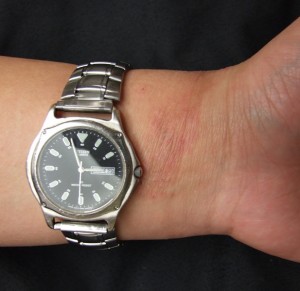Also known as … Contact Dermatitis or Contact Allergy
What is allergic contact dermatitis?
Dermatitis is a very common itchy red skin rash with a variety of types and causes (some types are also called eczema). It is common for a person with dermatitis to have more than one type, either at the same time, or at different times in their lives. Contact dermatitis arises from a chemical in contact with the skin which may cause either irritant or allergic dermatitis. Allergic contact dermatitis refers to dermatitis caused by a specific immune reaction to a chemical in contact with the skin.

All forms of dermatitis are caused by particular immune system attacks on the skin. The word “allergy” refers to a highly specific immune system attack against an allergen (a specific chemical). This means the immune system targets only that chemical or a very close relative of that chemical.
“Contact allergy” refers to the reaction against the chemical that occurs on contact with the skin (when the chemical touches the skin).
When the allergic reaction occurs soon (minutes) after contact and causes welts and redness, it is called “contact urticaria”.
When the reaction is delayed hours to a day or so after contact, it is called “allergic contact dermatitis” or ACD.
There are many chemicals capable of causing ACD and around 100 that are common culprits. Even if there has been long-term contact with a chemical without any problems, it is still possible to develop contact dermatitis to the chemical.
Areas of the body where the rash appears depend on where the chemicals come into contact with the skin. For instance:
- Hands or feet may be affected from chemicals in rubber in shoes or gloves.
- Ear-lobes or wrists may be affected from metal items such as earrings or watch parts containing nickel coming into contact with the skin.
- Neck or face may be affected from chemicals in perfumes coming into contact with the skin.
ACD usually needs more prolonged contact with the chemical to cause the rash. Australian coins contain nickel but usually we do not hold them long enough to cause a rash, even when a person is allergic to nickel. On the other hand, some plants can cause ACD simply by brushing past them (e.g. some grevilleas).
There is a broad range of possible causes of ACD including medications applied to the skin, cosmetics, hair dyes, textile dyes, plastic chemicals, rubber and glues, plants and many more.
Dermatitis varies from a mild dry red slightly itchy and quite localised rash to a severe weeping or blistering (fluid filled bubbles) rash and can be very widespread. Any part of the skin can be affected. ACD occurs at the point of contact of the offending chemical (allergen) and tends to appear slowly, starting hours to a day after contact. It may also spread beyond the contact area. Once contact with the allergen stops, the rash takes days to a few weeks to improve. If contact is prolonged, the dermatitis may also cause thick scaly skin.
The pattern of the rash and the specific history of exposure to items containing the particular allergen give your doctor clues to the likely cause. For instance if the rash is worse during the working week and less on weekends or holidays, a work-related cause may be suspected.
People allergic to one chemical are more prone, or more likely to be allergic to others. This could be due to the chemicals being close relatives of each other. It is also common for people with ACD to be allergic to more than one (sometimes many) unrelated chemicals. This may be due to exposure to many potentially allergic chemicals or because their immune system is somehow tuned to react more readily to them.
Immediate reactions (e.g. contact urticaria) can be identified by prick tests performed by allergists or some dermatologists, or by blood tests.
ACD is not identified by prick tests or blood tests as it is a delayed reaction to chemicals. This requires patch testing performed over 4 to 7 days. This involves applying sticky patches which hold small amounts of chemicals onto the skin (usually the back) for 2 days after which he results are interpreted 2 to 5 days later. Some dermatologists and allergists test with a small number of allergens whereas specialised clinics have access to a larger range of allergens. Interpreting the test results is complex. Be aware there are tests claiming to be allergy tests which have no scientific basis.

Treatment of ACD requires identifying the allergens and then avoiding exposure. This requires patch testing and knowing where the allergens are likely to be found. The rash should slowly clear once exposure is avoided. As people often have more than one type of dermatitis at the same time, avoiding allergens may only address one part of the problem. Steroid (anti-inflammatory) creams or steroid tablets will temporarily settle most cases of ACD.
The ability of the immune system to cause ACD lasts decades to a lifetime, similar to vaccinations. People prone to developing allergies may develop new ones over time.
Further information about allergic contact dermatitis
This information has been written by Dr Bruce Tate
Updated 10 August 2015
Disclaimer
2019 © Australasian College of Dermatologists.
You may use for personal use only. Please refer to our disclaimer.